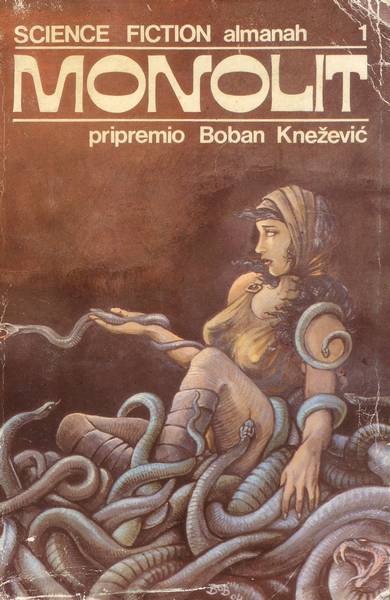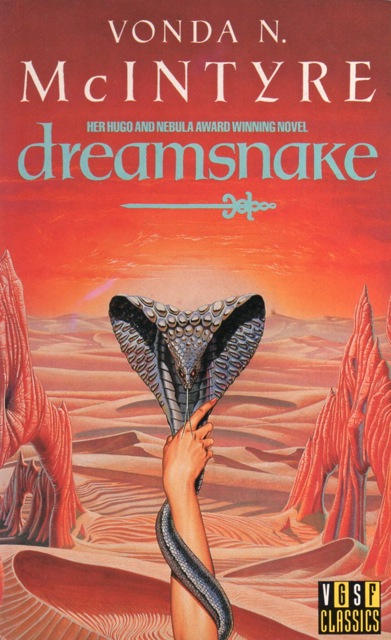 Dreamsnake won the Hugo, Nebula and Locus awards and was up for American Book, Ditmar and Tiptree awards.
Dreamsnake won the Hugo, Nebula and Locus awards and was up for American Book, Ditmar and Tiptree awards.SummaryThis is a novel about Snake, a healer who, while healing a child, loses her dream snake to an ignorant, fearful tribe. Dream snakes are rare, so she can't go home and grab another. But what else can she do? On her way home, she is grabbed by various people to heal although she is crippled by how much she can do with just two snakes. Like Dorothy on her way to Oz, she picks up motley companions en route. They pursue rumors of dream snakes to resolve not only Snake's loss but also the rarity of dream snakes among healers.
It is truly an enjoyable novel. But it's difficult to pinpoint why. (See below.)
Discussion with Minor Spoilers
 I spoke at some length about the opening here which was released as the Nebula-winning story "Of Mist, Grass, and Sand." I discussed three interpretive lenses of varying utility: 1) technology, 2) feminism, and 3) mythic motifs. While relevant, these seem to have less utility as the novel progresses but remain pertinent.
I spoke at some length about the opening here which was released as the Nebula-winning story "Of Mist, Grass, and Sand." I discussed three interpretive lenses of varying utility: 1) technology, 2) feminism, and 3) mythic motifs. While relevant, these seem to have less utility as the novel progresses but remain pertinent. In the story, questions lingered about what kind of world this was. The novel answers that: It's a post-nuclear holocaust where snakes have somehow been bestowed with healing powers. It may be best to squint; however, there are significant changes, with variable levels of technology--between the haves and have-nots, and no mixing allowed.
In the story, questions lingered about what kind of world this was. The novel answers that: It's a post-nuclear holocaust where snakes have somehow been bestowed with healing powers. It may be best to squint; however, there are significant changes, with variable levels of technology--between the haves and have-nots, and no mixing allowed.The mysticism involving the snakes melts away. We have a man who hungers for their bites as might a drug addict. The snakes' use and need seem more biological than mystery. Biology plays a role in the interaction with the technological haves, but it's also laden with fear. Biology also describes the problem that the healers had in having so few. (Writing this, it strikes me that of the three interpretive models in describing the opening story, Terry Carr's seemed the weakest, but his lens has gained most relevance in the novel overall.)
 I've gathered all of the relevant book covers, minus the salacious. Few if any really capture the book's spirit. The best is the recent top one. Her hair and body seem to be in motion until you look at the horse. It is a bit of a travelogue and a bit adventurous, but it doesn't hint at even a snake or what might be done with them. Others hint at a cyberpunk snake or primitive mystical religious rites. The "Monolit" one actually illustrates a scene toward the end, if leaving out a few details (in particular a child), but it still doesn't suggest the whole.
I've gathered all of the relevant book covers, minus the salacious. Few if any really capture the book's spirit. The best is the recent top one. Her hair and body seem to be in motion until you look at the horse. It is a bit of a travelogue and a bit adventurous, but it doesn't hint at even a snake or what might be done with them. Others hint at a cyberpunk snake or primitive mystical religious rites. The "Monolit" one actually illustrates a scene toward the end, if leaving out a few details (in particular a child), but it still doesn't suggest the whole.What is the whole? In some sense, it is the hole left by the absence of the dream snake. But that doesn't answer the question of what makes the novel tick.
It shouldn't work for two reasons: 1) It's episodic. It was released as short stories (which appeared in Ben Bova's Analog), cobbled together into a novel. 2) It's scope is small. This is the story of one woman on a modest mission to heal a few disadvantaged poor, not to save the world.

On the other hand, Charles Dickens wrote semi-episodic or serial novels for the newspaper and those hung together well. McIntyre does cinch the novel tohether. Moreover, We glimpse images of the wider world.
I do recommend it.




No comments:
Post a Comment